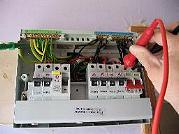James McMullen asks about calculating the earth fault loop impedance (Zs) and the accuracy of it. His question is answered by the NICEIC’s Technical Help Team (Theme – Distribution Equipment):

Question: I work for an electrical contracting company and have recently been having debates about whether it is acceptable to calculate Zs and why, when you do calculate it, it is not always very accurate.
Obviously, when a Zs reading is obtained and it is lower than the Ze + (R1+ R2), this is because of parallel earth paths, but sometimes it is also higher, which I'm lead to believe is to do with RCDs / MCBs.
If it is OK to calculate the Zs, then how can we be sure it is correct if, in different situations, the Zs can end up higher or lower?
Please could you explain this? Also, which is the correct and proper method?
I'm tired of telling my foreman that carrying out a Zs isn't necessary
Answer: It is an accepted practise to calculate a Zs reading if an R1+R2 value is obtained and a Ze is also obtained.
IT is recommended that a Zs value is obtained if there is an issue of parallel paths, and indeed, your measured value should always be less than your calculated value.
To see many more Q & A in Voltimum UK's Experts Area, please click on the link:
www.voltimum.co.uk/consult.php?universe=consult.index.questions